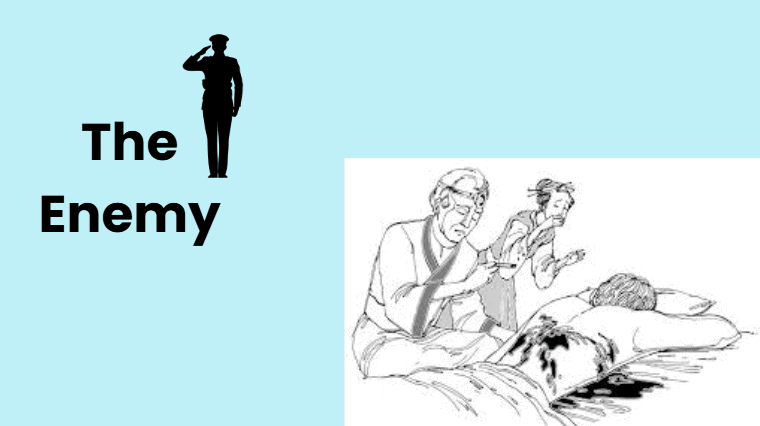The Enemy Class 12 English Vistas
| Table of contents |

|
| Key Points of the Story |

|
| Detailed Summary |

|
| Conclusion |

|
| Theme |

|
| Message |

|
| Difficult Words |

|
Key Points of the Story
The story is set during World War II and revolves around Dr. Sadao Hoki, a Japanese surgeon, who faces a moral dilemma when he discovers an injured American prisoner of war washed ashore near his home.
Dr. Sadao is torn between his duty as a doctor to save lives and his loyalty to Japan, which considers Americans the enemy.
Despite the risks, Dr. Sadao and his wife Hana decide to shelter and treat the wounded soldier, defying societal expectations and the disapproval of their servants.
The story explores themes of humanity, prejudice, and the conflict between personal ethics and national loyalty.
Ultimately, Dr. Sadao helps the soldier escape, highlighting the triumph of compassion over hatred.

Detailed Summary
Dr. Sadao Hoki is a highly skilled Japanese surgeon who was educated in America at his father’s insistence. While there, he met his wife, Hana, but delayed pursuing a relationship until he confirmed her pure Japanese lineage, knowing his traditional father would disapprove otherwise. Their marriage was later arranged in the Japanese custom upon their return to Japan.
Due to his expertise in medicine, Sadao was exempted from military service during World War II. Instead, he remained in Japan to treat a high-ranking General who might require surgery.
One evening, Sadao and Hana spotted a wounded man—an American prisoner of war—washed ashore. Despite knowing that harboring an enemy soldier was treasonous, they could not abandon him due to their humanitarian instincts. They brought him inside, intending to hand him over to authorities after treatment.
The soldier was placed in Sadao’s late father’s room. Sadao performed a risky surgery to save his life, while Hana cleaned him after their servant, Yumi, refused out of loyalty to Japan. The servants grew increasingly fearful and resentful, seeing their actions as unpatriotic.
As the prisoner recovered, Sadao struggled with his conscience. He drafted a letter to the police but never sent it, torn between duty and morality. Eventually, the servants abandoned the household, unable to tolerate the situation.
Sadao was summoned to treat the General, who offered to send assassins to eliminate the prisoner discreetly. Sadao agreed, but the General forgot due to his illness. For three nights, Sadao awaited the assassins, but they never came.
Realizing the danger of keeping the prisoner longer, Sadao helped him escape. He provided a boat, supplies, and instructions to reach a nearby uninhabited island, where the soldier could signal Korean fishermen for rescue. The prisoner gratefully departed.
Later, Sadao informed the General of the escape. The General apologized for his forgetfulness and praised Sadao’s loyalty. That night, Sadao saw no signal light, confirming the soldier’s safe escape.
In the end, Sadao reflected on his inability to kill the prisoner, questioning the prejudices that divide humanity. The story concludes with his internal conflict—why he, a man bound by duty, could not bring himself to commit an act of hatred.
Conclusion
The story underscores the power of human compassion to transcend the boundaries of war and nationalism. Dr. Sadao’s actions demonstrate that empathy and professional duty can override hatred and prejudice, even in the most challenging circumstances.
[Intext Question]
Theme
The central theme of the story is the conflict between duty and humanity. It explores how individuals navigate moral dilemmas during wartime, emphasizing the importance of compassion and the futility of blind nationalism. The narrative also critiques the dehumanizing effects of war and prejudice.
Message
The story conveys that humanity and ethical responsibility should prevail over hatred and division. It serves as a reminder that kindness and professionalism can bridge even the deepest divides imposed by war and politics.
Difficult Words
Haori: A loose outer garment worn over a kimono.
Stanch: To stop the flow of blood.
Pallor: Unhealthy pale appearance.
Anesthetic: A substance used to induce insensitivity to pain.
Hypodermic: A needle used for injecting substances under the skin.
Repulsion: Intense disgust.
Inert: Lacking the ability to move.
Dereliction: Neglect of duty.
Zeal: Great enthusiasm or devotion.
Stupefaction: A state of shock or astonishment.
|
30 videos|376 docs|100 tests
|
FAQs on The Enemy Class 12 English Vistas
| 1. What are some common criticisms of the humanities and arts? |  |
| 2. How do proponents of the humanities and arts defend their importance? |  |
| 3. How can studying the humanities and arts benefit society as a whole? |  |
| 4. What are some examples of successful individuals who have backgrounds in the humanities and arts? |  |
| 5. How can society better appreciate the value of the humanities and arts? |  |





















